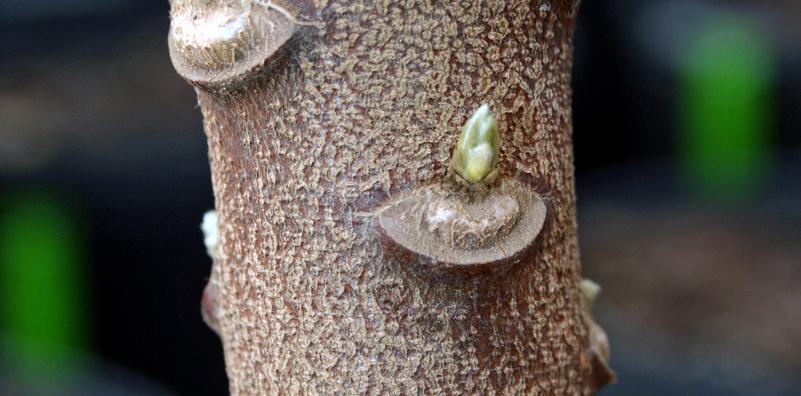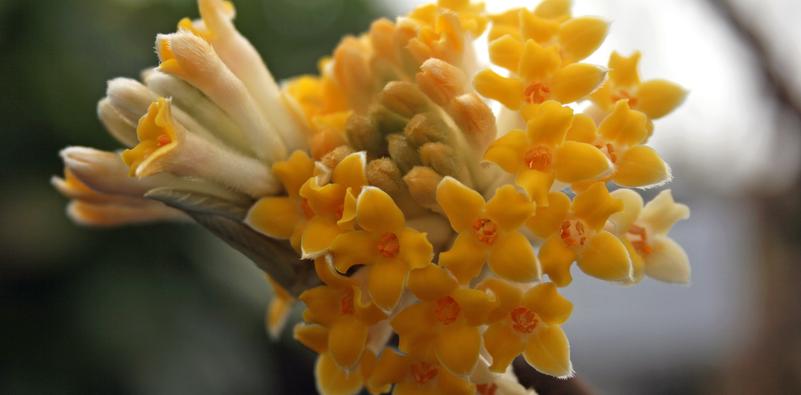Edgy Edgeworthia chrysantha
With so many of our plants currently working up their energy below the soil level, it might seem like there isn’t a whole lot to look at – unless you know exactly where to look, or you happen to be a big fan of winter garden specimens. One such specimen, Edgeworthia chrysantha, with its unique, delicately fragranced flowers coming into bloom, is quite the spectacle. Paperbush, as it’s commonly known, always seems to be a huge hit when it goes on the road with us to trade shows, attracting the attention of seasoned horticulturists and young, eager landscape architects alike.
For those of you unfamiliar with this showstopper of a shrub, Edgeworthia chrysantha is a no-fuss, suckering shrub belonging to the Daphne family (Thymelaeaceae), that offers a spectacular display of blooms at a peculiar time of the year. The downward-facing, semi-spherical inflorescences, each loaded with up to 40 flowers per flowerhead, begin by unfurling their outermost flower buds to reveal slender, tubular yellow flowers with silvery-whitish exteriors. The blooms are hard not to notice, topping the apical points of each branch, highly conspicuous without any foliage to conceal them from view. Even prior to opening, throughout the holiday months and well into January, the calices surrounding the buds appear as velvety, soft clusters that beg to be touched. Upon the arrival of the first flowers around late February and a full bloom around early March, the fuzzy calices pop open to reveal the yellow insides and deep orange reproductive structures.
Like most members of the Thymelaeaceae family, paperbush blooms are apetalous. Their lovely aroma is akin to that of gardenia flowers, and is often most noticeable and fragrant at night in the garden. Not only can Edgeworthia chrysantha complete a winter garden collection, but it can also make for a deliciously aromatic, seasonal cut flower in the home. Combine with red-twigged dogwood branches, some Ilex verticillata berries, fuzzy Salix catkins, and various juniper sprigs, and you’ve got yourself a stunning late winter arrangement.
The first time I was introduced to this plant by Arboretum Director Kathy Salisbury at Ambler Arboretum of Temple University, we were paraded to a corner with a bench within the Winter Garden, and tucked below a very peely-barked Lagerstroemia sat the yellow-blooming shrub. The pure delight that my fellow students and I felt was unmatched by many of the other leafless woody specimens we’d been studying at the end of winter, as we eagerly siphoned up the delicate scent, clamoring over each other to inhale the sweet floral perfume. I realize now how truly special that experience was, with so few specimens noted in the Philadelphia area. Here at Pleasant Run, our single Edgeworthia chrysantha specimen lives in the House Gardens, thriving at approximately 4’ tall with a suckering habit almost 5-6’ wide. Even over several years, when this plant wasn’t considered “hardy” to our zones, both of these specimens mentioned in Central New Jersey and Southeastern Pennsylvania had quite established themselves without any issues or concerns.
If this intriguing selection has yet to grace your presence, it’s likely because it was considered only marginally hardy up until fairly recently in this region. With a zone hardiness of 7-10, the intersection of the tristate NJ-PA-DE area is now prime real estate for growing Edgewortha chrysantha, which is even capable of tolerating zones 6a-6b with some winter protection (we’re looking at you, New York). In its homeland of China and the Himalayan Mountains, paperbush is often found growing along moist streambanks and within rich woodlands, proving its ability to handle dappled to partial shade. It is within its native region that it derives its common name, which it was given due to the use of the inner bark to make high quality paper.
Edgeworthia chrysantha is just as mysterious in landscape use as it is in ethnobotanical and physiological terms. Thought to be synonymous with E. papyrifera and E. tomentosa, Edgeworthia chrysantha is one of the only species within its genus to exist – there seems to be a bit of an argument amongst scholars as to how many species actually exist in the genus, however. E. papyrifera and E. chrysantha are often the topic of debate, as many consider them to be entirely different species, while others consider them to be taxonomically separate. Altogether, there is at maximum five currently documented species within the Edgeworthia genus. However, specific epithets aside, all Edgeworthia species are ideal for quality paper making. In the Tibetian Himalayas, it is actually Edgeworthia gardneri that is known for producing quality paper. In Japan, the inner bark of E. papyrifera is used to create banknotes, with perhaps the earliest known record of papermaking using the inner bark of this species having occurred at the end of the 16th century.
Should you be interested in attempting your own paperbush paper, your best bet is to venture out during the months of October and May, leaving space around its bloom time so as not to disturb its beauty, although collecting the inner bark after the foliage has already emerged ensures that the phloem is easier to remove from the outer bark. As much bark as possible should be removed while the material is still fresh and rather flexible, as its presence tends to weaken the fibrousness of the final paper quality. After drying for several weeks, the inner bark is then washed, cleaned, boiled, beaten into a pulp, and finally moulded into piece of handmade, quality paper. After moulding, the sheets must be dried and finished before being ready to sell or use. While a rather intensive process, the result is some of the most highly prized stationary in human civilization.
Traditionally, the bark and roots of paperbush were used in Southern China as part of a folk medicine called “Zhu shi ma”, an anti-inflammatory preparation used to remedy issues such as rheumatism and muscle pain. In vivo and in vitro studies performed by the Pharmaceutical Society of Japan -in 2008 confirmed the anti-inflammatory phytochemicals found within Edgeworthia chrysantha, namely three distinctive coumarins that were also found to inhibit pain signals and act as potent analgesics. Herbalists collect the bark and roots, dry them, and grind them into powders or utilize them in decoctions for the purpose of treating various inflammations.
As if it didn’t already have enough wonderful qualities, paperbush is also highly resistant to most pests and diseases in the landscape. Even during spring and summer, after the blooms have disappeared and the foliage has emerged, this shrub remains largely unbothered by fungal and bacterial issues, with no known insect issues. In high deer pressure areas, it tends to be mostly ignored even during seasonal periods of scarce food resources. During its growing period, when its full, velvety-looking foliage with silvery undersides takes over, the multi-stemmed, vase-shaped habit makes for a lovely specimen in the garden. Come autumn, the same buttery yellow touted by the winter inflorescences adorns the foliage, making sure that this shrub’s specific epithet, chrysantha, truly lives up to its name – chrysantha, meaning yellow, refers not only to the blooms, but the fall color of the leaves as well. We recommend a moist, well-drained, full sun to dappled shade spot for planting paperbush – preferably one that can be easily admired by passersby, such as along a pathway, foundation, or within accessible winter containers, with its fuzzy buds and fragrant blooms begging to be touched and sniffed.
Make sure to check out our available selection of Edgeworthia chrysantha in 3 and 7 gallons before they’re gone!
Just a quick note before we leave you this week: As we head into a brand-new growing season, it’s that time of year where a vast majority of our plant material has been trimmed, cleaned, or otherwise prepared for a push of healthy new growth with the rise of daylight hours and temperatures. Please feel free to contact us if you have questions about the current state of any available listed crops!
Breen, P. (n.d.). Landscape plants. Edgeworthia chrysantha | Landscape Plants | Oregon State University. https://landscapeplants.oregonstate.edu/plants/edgeworthia-chrysantha
Butler, R. (n.d.). What is Edgeworthia Chrysantha used for?. Green Packs. https://greenpacks.org/what-is-edgeworthia-chrysantha-used-for/
Flora of China Staff. (2024a). Edgeworthia chrysantha. Edgeworthia Chrysantha in Flora of china @ efloras.org. http://www.efloras.org/florataxon.aspx?flora_id=2&taxon_id=200014518
Flora of China Staff. (2024b). Thymelaeaceae. Thymelaeaceae in Flora of china @ efloras.org. http://www.efloras.org/florataxon.aspx?flora_id=2&taxon_id=10894
Gardenia.net Staff. (n.d.). Edgeworthia Chrysantha (Paperbush). Gardenia. https://www.gardenia.net/plant/edgeworthia-chrysantha
Helman-Ważny, A. (2016). Tibetan Manuscript and Xylograph Traditions | The Written Word and Its Media within the Tibetan Culture Sphere. Academia.edu. https://d1wqtxts1xzle7.cloudfront.net/75755300/Almogi_2016_ed_Tibetan_Manuscript_and_Xylograph_Traditions-libre.pdf?1638729118=&response-content-disposition=inline%3B+filename%3DAlmogi_2016_ed_Tibetan_Manuscript_and_Xy.pdf&Expires=1707505901&Signature=ZnCY1-2TYcBBV0KfSS0vorIdvlL6XHgdkOG0GRq-BP-rCI6zMRkitQOhKFzembsNg34BGtBLrKQx4s0-dwwei3omLNjAKGVCHyij-vvpqC41mGaL6--3utmTppt-XFcZjS0zQWCbBUq-svmmxvC5g-abSLwgZjn2mozBupawL-1kUHm-0vzKUZcHHIcc-l7AtK9L~6FS5xBKocX8W4xA7j8DFEJb~eqs~6Ttb8XyIx6xFY--tNCecUOX5II7WoupCHgXBBy1Wc0cyDr3WGObvYbt72YgMQXvGlRCmnt7ZamDvIRyaJA7XBepTYsV0IHu2TkTZunJLzjkk1h9gf01QQ__&Key-Pair-Id=APKAJLOHF5GGSLRBV4ZA#page=179
Hu, X.-J., Jin, H.-Z., Xu, W.-Z., Chen, M., Liu, X.-H., Zhang, W., Su, J., Zhang, C., & Zhang, W.-D. (2008). Anti-inflammatory and analgesic activities of Edgeworthia Chrysantha and its effective chemical constituents. Biological and Pharmaceutical Bulletin, 31(9), 1761–1765. https://doi.org/10.1248/bpb.31.1761
Pinsker, M. (2009, April 24). Edgeworthia Chrysantha. Scott Arboretum. https://scott-dev.domains.swarthmore.edu/edgeworthia-chrysantha-2/
University of Alabama Staff. (2013). Landscape shrubspaperbush(edgeworthia chrysantha). Paperbush (Edgeworthia chrysantha). https://www.uaex.uada.edu/yard-garden/resource-library/plant-database/shrubs/paperbush.aspx
Wagner-Reiss, K. (2023, March 6). Plant names and provenance: Edgeworthia Chrysantha (paperbush). Morris Arboretum & Gardens. https://www.morrisarboretum.org/blog/plant-names-and-provenance-edgeworthia-chrysantha-paperbush
Walker, C. (2018, November 12). A shrub for all seasons: Edgeworthia. CAROLYN’S SHADE GARDENS. https://carolynsshadegardens.com/2012/12/10/a-shrub-for-all-seasons-edgeworthia/
See all our Woody Ornamentals

